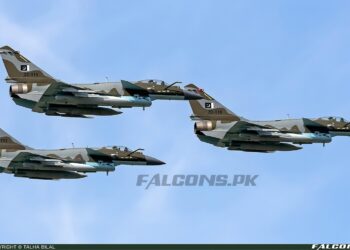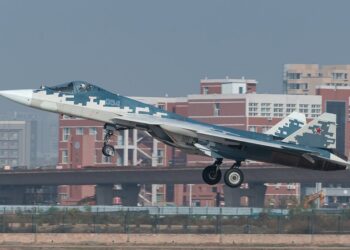By Oliver Parken
Turkey’s Baykar company says its Bayraktar TB3 armed drone has completed its first flight. TB3 is slated to become the primary uncrewed platform of the Turkish Navy’s ‘drone carrier’ TCG Anadolu, providing both light strike capabilities and persistent surveillance at sea.
The drone took to the sky for its inaugural flight on October 27, according to Baykar. This took place at the Çorlu Flight Training and Test Center, which is located in northwest Turkey.
It is worth noting that TB3’s official first flight comes shortly after Baykar announced on October 23 that TB3 had completed takeoff and landing tests. The exact details of what that testing consisted of are unclear, but video the company released certainly looks to show the drone in mid-air, though perhaps short of a full sortie.
TB3, which has been in development for several years and which first broke cover earlier in March this year, is a naval variant of Baykar’s combat-proven TB2. TB2 has been used extensively during the recent war in Ukraine, as well as in Syria, Libya, and Nagorno-Karabakh in the past.
In terms of its specifications, TB3 has a wingspan of 14 meters (some 46 feet) and a length of 8.35 meters (27 feet). The drone has a maximum takeoff weight of 1,450 kilograms (some 3,196 pounds) and a payload capacity of 280 kilograms (617 pounds). According to Baykar, this represents a significant increase compared to the respective figures of TB2 — 750 kilograms (1,653 pounds) and 130 kilograms (286 pounds). Employing a 172-horsepower PD170 engine, TB3 is expected to have a range of 1,000 nautical miles and over 24 hours of on-station endurance.
In terms of armament, the drone features six hardpoints under its foldable wings, allowing it to carry various munitions including laser-guided rockets, anti-infantry bomblets, and anti-tank missiles. Alongside its strike capabilities, TB3 will primarily be used for intelligence, surveillance, and reconnaissance (ISR) operations. It has beyond-line-of-sight communications capabilities that will extend the eyes of Anadolu over vast swathes of ocean. It’s ability to carry various modular systems could also make it an ideal communications relay platform.
TB3’s short-takeoff-and-landing (STOL) capabilities make it ideal for use on aircraft carriers as well as big-deck amphibious assault ships. Being able to conduct short takeoffs and landings also extends the drone’s operational capability to small, remote airstrips ashore, too — affording Turkish forces greater flexibility during land-based operations.
“On the Republic of Turkey’s centennial, the Bayraktar TB3 uncrewed aerial vehicle successfully completed its maiden flight,” Baykar’s Chief Technology Officer (CTO), Selçuk Bayraktar, said at the Çorlu Flight Training and Test Center on October 27.
Baykar expects TB3 to enter full mass production in 2024, and be ready to serve aboard Anadolu the same year. The drone’s first flight points to the continued vitality of Turkey’s domestic drone production, especially in support of its drone-carrying mothership ambition. Originally ordered in 2015, laid down in 2018, and launched in 2019, Anadolu was delivered to the Turkish Navy in May 2023. The ship boasts a typical landing helicopter dock (LHD) configuration, with a large flight deck with a ski-jump on top and a well deck at the rear. The ship can carry various tanks, amphibious assault vehicles, armored personnel carriers, and landing craft for amphibious assault operations.
It should be noted that Anadolu was not originally intended to function as a ‘drone carrier,’ but rather support either F-35B stealth jets or AV-8B Harrier IIs. However, in 2019 Turkey was booted from the F-35 program by the U.S. in response to Ankara’s purchase of Russian S-400 air defense systems.
Without carrier-capable short takeoff and vertical landing (STOVL) F-35Bs to fill its decks, and in response to the rise of uncrewed systems, it was reported earlier this year that Anadolu would undergo slight refits to its infrastructure to better support drone operations.
This included the addition of drone control stations with satellite terminals for longer-range connections, the installation of a ‘roller system’ at the ship’s bow to launch uncrewed platforms, arresting gear on deck to accommodate unmanned combat air vehicle (UCAV) landings, and safety nets for smaller drone recovery.
As Turkey’s Ministry of National Defense indicated earlier this year, Anadolu “can deploy 12 manned or unmanned combat aircraft… and [UCAVs] depending on the operation to be carried out within the scope of the aircraft transport capability.” It also has the ability to deploy other aerial assets, too, including nearly up to two dozen helicopters.
As well as its work on TB3, Baykar is also developing a fighter-like drone capability that supposedly may find its way on Anadolu known as Kizilelma, meaning Red Apple in Turkish. Kizilelma completed its first flight back in December 2022, and Baykar aims to begin production of the system next year, with the drone being potentially ready to serve on board in Anadolu as early as 2025, according to official statements. We will have to wait and see how its development progresses and if it ends up on the ship in a robust capacity at all, let alone when.
Kizilelma, which The War Zone has previously profiled, is tailored for the sort of air combat missions usually performed by manned fighter aircraft. Powered by a single Ukrainian-designed Ivchenko-Progress turbofan engine, the system boasts a canard-delta configuration and, at least on later versions, is supposedly capable of supersonic flight. The Kizilelma should have an endurance of around five to six hours, a service ceiling of 35,000 feet, and a combat radius of 500 nautical miles. With a maximum takeoff weight of 13,228 pounds, Kizilelma will boast a payload capacity of 3,306 pounds and will likely support various Turkish air-to-ground precision munitions and air-to-air missiles.
Of course, Turkey is not the only country investing in naval drones, and procuring new or adapting existing vessels to accommodate them. Militaries around the globe are increasingly looking to uncrewed platforms as part of the future of maritime and amphibious assault operations.
The U.S. Navy, for example, sees its future carrier air wings featuring up to 60 percent pilotless aircraft. This will include Navy equivalents to the Air Force’s Collaborative Combat Aircraft, or CCAs, future drones that will feature high levels of autonomy and which will be able to collaborate with crewed systems. The MQ-25 Stingray tanker and ISR aircraft is already deep into flight testing and will be the first operational advanced drone on American carrier decks.
As The War Zone has noted previously, the Navy is looking to operate advanced drones from a whole range of vessels in the future — from expeditionary sea bases to destroyers. This speaks to its desire to operate over much wider areas, generating the critical ‘combat mass’ required for a possible future conflict in the Pacific theater.
More closely analgous to the TB3, General Atomics has devised a wing-kit that will turn its MQ-9 Reapers into carrier-deployable drones. The company also has its Mojave that is a purpose-built STOL medium altitude, long-endurance combat drone that would be very suited for a similar role. Mojave will soon be trialed from the deck of one of the Royal Navy’s two Queen Elizabeth class carriers.
The Royal Navy is also looking to adapt its two aforementioned Queen Elizabeth class carriers with the necessary assisted launch systems and recovery gear to deploy various fixed-wing uncrewed assets and possibly conventional takeoff and landing crewed types. In September, the service successfully conducted a drone landing and takeoff aboard HMS Prince of Wales. At present, the carriers are able to operate F-35Bs as well as helicopters.
In that vein, China has also increasingly working to develop various tiers of drones for use aboard its aircraft carriers and big deck amphibs. In the recent past, for example, we’ve seen at least two different types of commercial or commercial-derivative lower-end drones that feature vertical takeoff and landing capability on the deck of the aircraft carrier Shandong. Beyond that, China is working to enable its amphibious assault ships to carry various advanced drones, including stealthy ones that may or may not be armed.
Other naval arms around the globe that are in the big-deck amphibious assault ship or carrier club are also closely examining similar options, but Turkey is certainly becoming a very bold actor in this regard.
It will be interesting to see what comes next for Turkey, which is clearly a major player in developing naval drones, as it continues to move forward with its ‘drone carrier’ ambitions.






